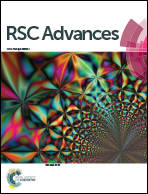A label-free amperometric immunosensor for the detection of carcinoembryonic antigen based on novel magnetic carbon and gold nanocomposites†
Abstract
In this work, a novel label-free electrochemical immunosensor was developed for the quantitative detection of carcinoembryonic antigen (CEA). To this end, gold nanoparticle (Au NP) functionalized magnetic multi-walled carbon nanotubes (MWCNTs–Fe3O4) were prepared and applied to lead ion (Pb2+) adsorption. Because of the synergetic effect present in Pb2+@Au@MWCNTs–Fe3O4, they show better electrocatalytic activity towards the reduction of hydrogen peroxide (H2O2) than MWCNTs, MWCNTs–Fe3O4 or Au@MWCNTs–Fe3O4. Featuring a large specific surface area, good biocompatibility and excellent electrical conductivity, Pb2+@Au@MWCNTs–Fe3O4 were used as transducing materials to achieve efficient conjugation of capture antibodies and signal amplification of the proposed immunosensor. Cyclic voltammetry and the amperometric i–t technique were used to record the change of electrochemical signal when the electrodes were modified with different concentrations of CEA. Under optimal conditions, the label-free immunosensor exhibited a wide linear range from 5 fg mL−1 to 50 ng mL−1 with a low detection limit of 1.7 fg mL−1 for CEA. The proposed immunosensor displays high electrochemical performance with good reproducibility, selectivity and stability, and has great potential in clinical and diagnostic applications.


 Please wait while we load your content...
Please wait while we load your content...